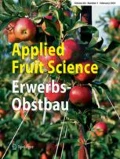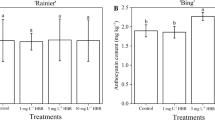Abstract
The study was conducted to determine the effects of different rootstocks (Ma × Ma 14, GiselA 5, GiselA 6 and SL 64) on quality properties and bioactive compounds of ‘0900 Ziraat’ sweet cherry fruit. Fruit weight, thickness and length of Ma × Ma 14 and SL 64 was higher than the GiselA 5 and GiselA 6. Firmness of GiselA 6 was lower than the other rootstocks (Ma × Ma 14, GiselA 5 and SL 64). The chroma value of GiselA 5 was greater than the other rootstocks, whereas the hue angle of SL 64 was lower than the other rootstocks. While the lowest SSC and acidity was obtained in GiselA 5, the highest vitamin C was determined in Ma × Ma 14. Total phenolics and total flavonoids, thus antioxidant activity of GiselA 6 and SL 64 rootstocks was higher than Ma × Ma 14 and GiselA 5 rootstocks. Catechin was the major phenolic acid in ‘0900 Ziraat’ sweet cherry fruit. GiselA 6 had higher catechin and 4‑hydroxybenzoic acid content than the other rootstocks. As a result, it was revealed that sweet cherry rootstocks were effective on bioactive compounds and fruit quality characteristics.
Similar content being viewed by others
References
Aglar E, Yıldız K (2014) Influence of rootstocks (Gisela 5, Gisela 6, Ma x Ma, SL 64) on performance of 0900 Ziraat sweet cherry. J Basic Appl Sci 10:60–66
Benzie IFF, Strain JJ (1996) The ferric reducing ability of plasma (FRAP) as a measure of antioxidant power: the FRAP assay. Anal Biochem 239:70–76
Beyhan O, Elmastas M, Gedikli (2010) Total phenolic compounds and antioxidant capacity of leaf, dry fruit, and fresh fruit of feijoa (Acca sellowiana, Myrtaceae). J Med Plants Res 4:1065–1072
Blazkova J, Hlusickova I, Blazek J (2002) Fruit weight, firmness and soluble solids content during ripening of Karesova cv. sweet cherry. HortScience 29:92–98
Blois MS (1958) Antioxidant determinations by the use of a stable free radical. Nature 26:1199–1200
Cantin CM, Pinochet J, Gogorcena Y, Moreno MA (2010) Growth, yield and fruit quality of ‘Van’ and ‘Stark Hardy Giant’ sweet cherry cultivars as influenced by grafting on different rootstocks. Sci Hortic 123:329–335
Chang CC, Yang MH, Wen HM, Chern JC (2002) Estimation of total flavonoid content in propolis by two complementary colorimetric methods. J Food Drug Anal 10:178–182
Čmelik Z, Druzic Orlic J (2008) Performance of some sweet cherry cultivars on ‘Weiroot 158’ rootstock. Acta Hortic 795:345–348
Crisosto CH, Crisosto GM, Metheney P (2003) Consumer acceptance of ‘Brooks’ and ‘Bing’ cherries is mainly dependent on fruit SSC and visual skin color. Postharvest Biol Technol 28(1):159–167
Daza A, Garcia-Galavis PA, Grande MJ, Santamaria C (2008) Fruit quality parameters of “Pioneer” Japanese plum produced on eight different rootstocks. Sci Hortic 118:206–211
Diaz-Mula HM, Castillo S, Martı’nez-Romero D, Valero D, Zapata PJ, Guillen F, Serrano M (2009) Sensory, nutritive and functional properties of sweet cherry as affected by cultivar and ripening stage. Food Sci Technol Int 15:535–543
Fazzari M, Fukumoto L, Mazza G, Livrea MA, Tesoriere L, Di Marco L (2008) In vitro bioavailability of phenolic compounds from five cultivars of frozen sweet cherries (Prunus avium L.). J Agric Food Chem 56:3561–3568
Ferretti G, Bacchetti T, Belleggia A, Neri D (2010) Cherry antioxidants: from farm to table. Molecules 15(10):6993–7005
Gonçalves B, Moutinho-Pereira J, Santos A, Silva AP, Bacelar E, Correia C, Rosa E (2006) Scion–rootstock interaction affects the physiology and fruit quality of sweet cherry. Tree Physiol 26:93–104
Hajagos A, Spornberger A, Modl P, Vegvari G (2012) The effect of rootstocks on the development of fruit quality parameters of some sweet cherry (Prunus avium L.) cultivars, ‘Regina’ and ‘Kordia’, during the ripening process. Acta Univ Sapientiae Agric Environ 4:59–70
Jakobek L, Seruga M, Voca S, Sindrak Z, Dobricevic N (2009) Flavonol and phenolic acid composition of sweet cherries (cv. Lapins) produced on six different vegetative rootstocks. Sci Hortic 123:23–28
Jimenez S, Garı’n A, Betra’n JA, Gogorcena Y, Moreno MA (2007) Influence of different vigour cherry rootstocks on leaves and shoots mineral composition. Sci Hortic 112:73–79
Kim DO, Heo HJ, Kim YJ, Yang HS, Lee CY (2005) Sweet and sour cherry phenolics and their protective effects on neuronal cells. J Agric Food Chem 53:9921–9927
Kroon PA, Williamson G (1999) Hydroxycinnamates in plants and food: current and future perspective. J Sci Food Agric 79:355–361
Lanauskas J, Kviklys D, Uselis N, Viškelis P, Kviklienė N, Buskienė L (2014) Rootstock effect on the performance of sweet cherry (Prunus avium L.) cv. ‘Vytėnu rožinė’. Zemdirbyste 101:85–90
Long EL, Kaiser C (2010) Sweet cherry rootstocks for the Pacific Northwest a Pacific Northwest extension publication. PNW 619. Oregon State Univertsity—University of Idaho—Washington State University, USA
Lopez-Ortega G, Garcia-Montiel F, Bayo-Canhaa A, Frutos-Ruiza C, Frutos-Tomas D (2016) Rootstock effects on the growth, yield and fruit quality of sweetcherry cv. ‘Newstar’ in the growing conditions of the Region of Murcia. Sci Hortic 198:326–335
Mainla L, Noormets M, Moor U, Karp K, Jalakas M (2008) Effect of rootstock on taste-related properties of nordic apple cultivars. Acta Hortic 903:405–410
Matilla P, Hellström J, Törrönen R (2006) Phenolic acids in berries, fruits and beverages. J Agric Food Chem 54:7193–7199
Mozetic B, Trebse P, Hribar J (2002) Determination and quantitation of anthocyanins and hydroxycinnamic acids in different cultivars of sweet cherries (Prunus avium L.) from Nova Gorica region (Slovenia). Food Technol Biotechnol 40:207–212
Ozturk B, Yıldız K, Kucuker E (2015) Effect of pre-harvest methyl jasmonate treatments on ethylene production, water-soluble phenolic compounds and fruit quality of Japanese plums. J Sci Food Agric 95:583–591
Pal MD, Mıtre I, Asanıca AC, Sestraș AF, Petıcıla AG, Mıtre V (2017) The influence of rootstock on the growth and fructification of cherry cultivars in a high density cultivation system. Not Bot Horti Agrobot 45:451–457
Popescu M, Popescu GC (2015) Effects of dwarfing GiselA 5 rootstock on reproductive potential, vegetative growth, and physiological features of some sweet cherry cultıvars in high-density sweet cherry orchards. Curr Trends Nat Sci 4:82–90
Rato AE, Agulheiro AC, Barroso JM, Riqelme F (2008) Soil and rootstock influence on fruit quality of plums (Prunus domestica L.). Sci Hortic 118:218–222
Serra AT, Duarte RO, Bronze MR, Duarte CMM (2011) Identification of bioactive response in traditional cherries from Portugal. Food Chem 125:318–325
Sitarek M, Bartosiewicz B (2012) Influence of five clonal rootstocks on the growth, productivity and fruit quality of ‘Sylvıa’ and ‘Karına’ sweet cherry trees. J Fruit Ornam Plant Res 20:5–10
Spinardi AM, Visai C, Bertazza G (2005) Effect of rootstock on fruit quality of two sweet cherry cultivar. Acta Hortic 667:201–206
Tareen MJ, Tareen MN (2004) Effect of Rootstocks on “Bing” Cherry Grown in Balochistan (Pakistan). Int J Agric Biol 1560:565–567
Tavarini S, Gil MI, Tomás-Barberán FA, Buendia B, Remorini D, Massai R, Degl Innocenti E, Guidi L (2011) Effects of water stress and rootstocks on fruit phenolic composition and physical/chemical quality in Suncrest peach. Ann Appl Biol 158:226–233
Treutter D, Feucht W, Schmid PPS (1986) Polyphenole des Phloems in Beziehung zur Inkompatibilität von Interspezifischen Prunus-Veredlungen (Prunus avium L., Prunus cerasus L.)—Flavanone und Flavanole über der Veredlungsstelle. Gartenbauwissenschaft 51:77–84
Usenik V, Štampar F (2000) Influence of various rootstocks for cherries on p‑coumaric acid, genistein and prunin content and their involvement in the incompatibility process. Gartenbauwissenschaft 65:245–250
Usenik V, Štampar F (2002) Influence of scion/rootstock interaction on seasonal changes of phenols. Phyton 42:279–289
Usenik V, Krška B, Vičan M, Štampar F (2006) Early detection of graft incompatibility in apricot (Prunus armeniaca L.) using phenol analyses. Sci Hortic 109:332–338
Usenik V, Fabcic J, Stampar F (2008) Sugars, organic acids, phenolic composition and antioxidant activity of sweet cherry (Prunus avium L.). Food Chem 107:185–192
Usenik V, Fajt N, Mikulic-Petkovsek M, Slatnar A, Stampar F, Veberic R (2010) Sweet cherry pomological and biochemical characteristics influenced by rootstock. J Agric Food Chem 58:4928–4933
Whiting DM, Lang G, Ophard D (2005) Rootstock and training system affect sweet cherry growth, yield and fruit quality. HortScience 40:582–586
Whiting MD, Ophardt D, McFerson JR (2006) Chemical blossom thinners vary in their effect on sweet cherry fruit set, yield, fruit quality, and crop value. horttech 16:66–70
Yildiz K, Kilic K, Ozkan Y, Ozturk B, Kucuker E (2018) The role of pre-harvest aminoethoxyvinylglycine (AVG) treatments on total phenolics, antioxidant capacity and fruit qualityattributes of sweet cherry cultivars. Erwerbs-Obstbau 60:221–230
Zhang C, Whiting MD (2011) Improving ‘Bing’ sweet cherry fruit quality with plant growth regulators. Sci Hortic 127:341–346
Author information
Authors and Affiliations
Corresponding author
Ethics declarations
Conflict of interest
O. Karakaya, B. Ozturk, E. Aglar and H.I. Balik declare that they have no competing interests.
Rights and permissions
About this article
Cite this article
Karakaya, O., Ozturk, B., Aglar, E. et al. The Influence of the Rootstocks on Biochemical and Bioactive Compound Content of ‘0900 Ziraat’ Sweet Cherry Fruit. Erwerbs-Obstbau 63, 247–253 (2021). https://doi.org/10.1007/s10341-021-00542-0
Received:
Accepted:
Published:
Issue Date:
DOI: https://doi.org/10.1007/s10341-021-00542-0




